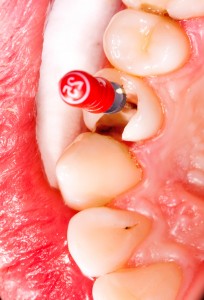Preparing for a Root Canal

Nobody wants a cavity, but they happen millions of times a year for Americans. When cavities aren’t found promptly with biannual dental exams, they can grow large. When a cavity gets so large that it affects the nerves of your teeth, a root canal may be needed. This is when a tooth is completely cleaned of infection all the way through the roots of the tooth. If you need a root canal, use this information to understand what one is and how it is done so you are prepared for your appointment!
Tooth Decay
When you eat, sugars in your food mix with your mouth bacteria, creating a sticky film called plaque. That plaque sticks to your teeth instead of being swallowed, and what’s worse is that it is acidic. This is because mouth bacteria consumes the sugar and then creates an acid with that consumption.
If you don’t brush and floss your teeth enough, that plaque will make a home along your gum line, and the acids in it will work to break up your tooth minerals. The teeth are essentially hard-packed minerals, which is why they are so hard. However, plaque weakens the tooth and creates tiny cracks and openings, causing decay towards the inside of the tooth. You can have surface cavities that change color and are visible, but many cavities are inside the tooth. With enough decay, plaque, bacteria and decay reach the center of the tooth where your blood vessels, nerves and soft pulpy tooth tissue are. Then, that bacteria creates infection that becomes painful very quickly.
Root Canals 101
For small cavities—or ones that have not yet caused you pain—you can get that part of your tooth drilled out and refilled with composite resin (tooth replacement material) at your dental appointment. However, You may need a root canal if you have started to experience pain, swelling, redness, heat and more around a tooth.
Root canals—or the practice of doing them—are referred to as “endodontics”. The American Association of Endodontists state that “all endodontists are dentists”, but less than 3% of all dentists have been trained in endodontics. Dentists who do this procedure have to go to 2 or more years of schooling after dental school. However, dentists also perform root canals, they just do it a couple of times a week instead of full time. On any given day, there are about 41,000 root canals being done in the United States. In a year, that’s about 15 million root canals, or treatments to remove decay in the tooth center and the roots.
A root canal is different than a cavity filling or a cavity removal. This is because decay has spread to your nerves, blood vessels and tooth center where soft tissues lie instead of simply affecting the hard mineral parts of your teeth. That center decays and infections can start to spread to your bloodstream, which can be very serious to your health. The way to fix that infection and the severe decay without removing your entire tooth is to perform a root canal.
What to Expect During Your Root Canal
There are some myths out there regarding root canals. For one, it’s not better to have your tooth removed instead of getting your tooth roots cleaned. It’s always better to opt for keeping your natural teeth, and a root canal allows you to do just that. It is the step between cavity fillings and a tooth extraction, which you don’t want unless you can help it.
If we find severe tooth decay, we will set an appointment to remove that decay. If you are already at the stage of pain and spreading infection, you will likely have a same-day appointment, as those decay infections can become serious quickly. Root canals won’t cause you illness, but will save you from it, as we remove bacteria and infection throughout your entire tooth, all the way down through your roots.
Your root canal procedure will begin with a through evaluation and x-ray session. Following this, your mouth will be treated with local anesthesia to numb the area we will be working on and to ensure you optimum comfort. A rubber dam will be placed over the tooth to isolate it during treatment. Dr. Evanson will then proceed to drill a small hole in the wall of your tooth. After she has done this she is able to extract the infected tissue, nerves and pulp. After the problem materials are extracted from your tooth, the canals of the tooth are cleaned and flushed with a sterilizing solution prior to being sealed off. On a later visit, Dr. Evanson will then fill the empty root canal with a rubber compound called “gutta percha” and will add an onlay or inlay to the tooth followed by a dental crown to protect the enamel.
What to Expect After Your Root Canal
Directly after your root canal, you will be numb from the anesthetic administered. That numbness can last just a few hours or it may last all day depending on how your body reacts to anesthetic. Since most or all of the pulp is removed in a root canal, the tooth becomes relatively fragile after being sealed. Dr. Evanson and her team will finish the procedure by installing a crown to protect it. The crown will need occasional replacement every 15 years or so, but it is the best way to prevent the repaired tooth from cracking. Taking good care of your entire mouth with regular flossing and brushing is the key to a long lasting crown. It will also prevent you from needing a recurrent root canal or a similar procedure on a different tooth.
The restoration we do on your tooth allows you to keep your natural tooth for years to come, which is what you want. If you are due for a comprehensive exam to check for cavities, or are experiencing tooth pain, call Dr. Evanson’s office at (720) 409-0008!
Leave a reply →








